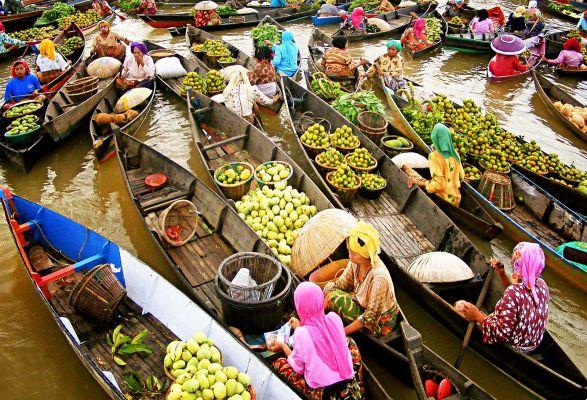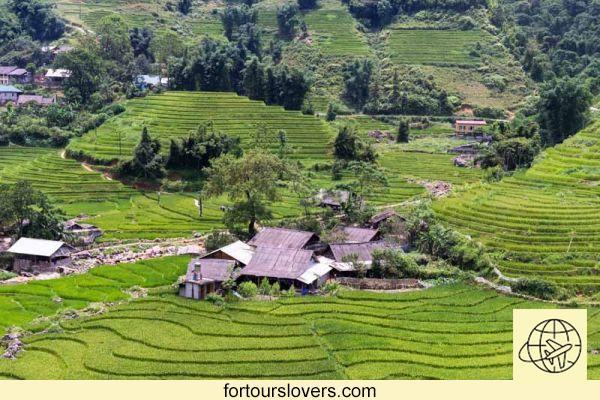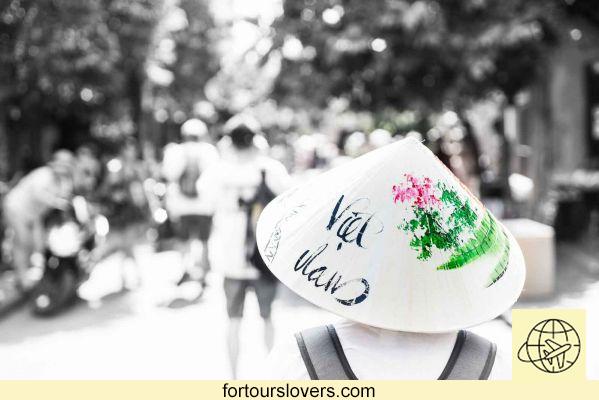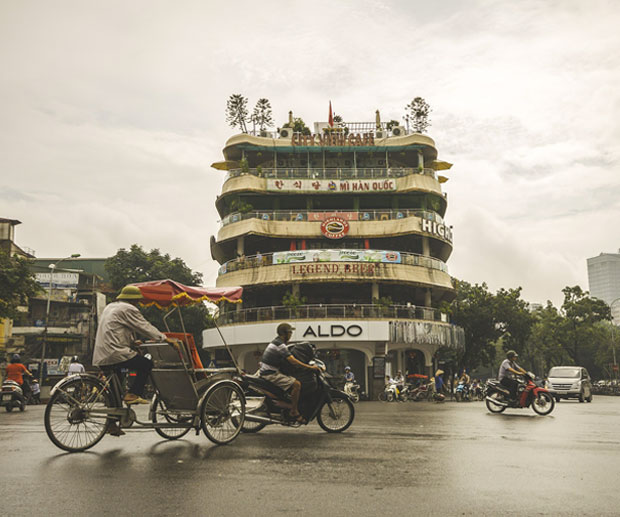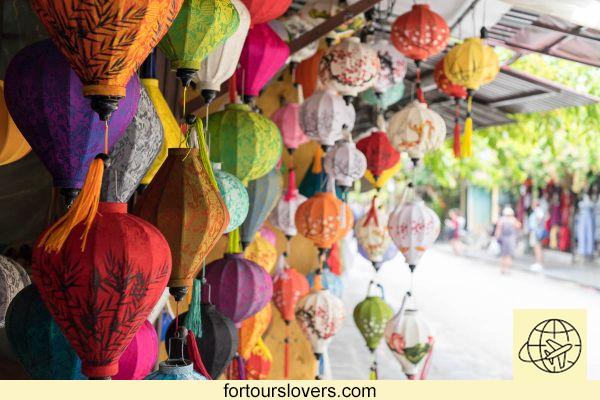
You might be interested in these articles of mine:
- The itinerary of my trip to Vietnam
- Sapa, trekking among the rice fields and ethnic minorities
- What to see in Hanoi
- Visit Halong Bay, a natural paradise
Tips for DIY travel to Vietnam
I therefore hope to answer most of your doubts.
By clicking on the item that interests you in the index, you will immediately go to the part of the post where it talks about that topic.
Costs in general
Traveling to Vietnam is cheap. The main cost therefore remains that of flying to Vietnam. There everyday life costs very little compared to the cost of living in the West but we must always be careful because the scam towards the tourist is always around the corner.
The costs of the hotels I defined them when creating the itinerary in Vietnam, spending from a minimum of 15 euros to a maximum of 30 euros for a double room with breakfast included.
The costs of food they are ridiculous, you can spend a few euros (in dong) as a few more but I assure you that with a dinner of 600.000 dong (about 25/30 euros) you will certainly be satisfied. I spent this amount in a beautiful restaurant in Hoi An. Figures that in Italy would barely allow you a pizza. In addition, there is no tip and no tip.
Transport costs too they are low, a taxi ride will cost between 6.000 Dong to 16.000 Dong per kilometer, a pick-up from Hanoi airport to the old quarter of Hanoi about 18 dollars (total cost of the car) for 45 minutes by road. We were two, if you are 4/5 to travel to Vietnam in DIY mode, the transport costs will be even less incisive.
Traveling to Vietnam is therefore cheap except for excursions with agency such as in Sapa or in the Halong Bay cruise (click to read the article). In that case the prices will be much higher, for example the cruise I have chosen costs $ 340 per person for 3 days and 2 nights, even if you must consider that within this price all meals and even nights are included.
Dong, dollars and payment information
Dong look like Monopoly paper banknotes (with all due respect), even the consistency is similar and the minimum denomination starts from 1.000 Dong and a maximum from 500.000 Dong (you will feel like you are rich). This means that there are no coins, all payments are made via paper banknote. You will always find yourself with lots of banknotes in your pocket and initially you will struggle to understand the value of each banknote.
But for traveling to Vietnam my advice is to always have dongs close at hand as daily life must be paid for in Dong. You can pay for hotels and restaurants by credit card but you pay for everyday purchases with local currency.
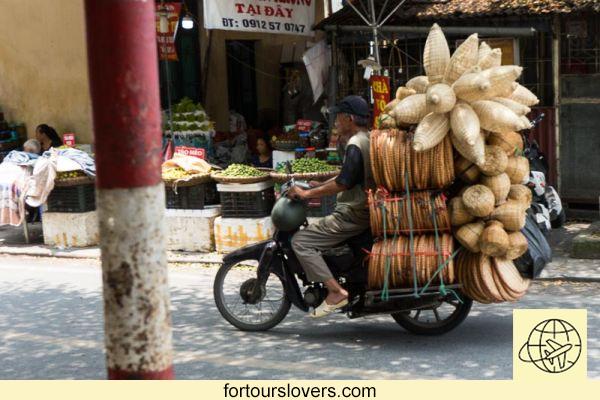
Do you want to stop for a coffee, drink something, buy some gifts or simply pay for the taxi? Pay in Dong.
Sometimes you will think in dollars, this can happen when you request a paid pick-up from hotels.
Where to exchange euros in dong?
I started this trip in Vietnam with the belief that, like all countries, the change at the airport was less convenient than in the city center. I was wrong.
I don't understand why but the change at the airport was for 1 euro = 26.700 Dong, in the cities it ranged between 26.000 and 26.700 Dong.
I have to clarify one thing: in Hanoi and also in other cities there are no real exchanges (or at least I have not found them). If you want to change euros into Dong you have to contact the jewelers who also offer this service, but it is not easy to find them. Otherwise you go to the bank.
Recommended food and restaurants
One of the things I like most about “DIY trips” is that you have to decide each variable yourself. And among these variables there is always the food aspect. If one day I want to eat street food I can do it, if I don't want to eat the same, if I want to eat in a cheap or expensive restaurant the choice is entirely up to me.
And in a trip to Southeast Asia I think it's the best thing. There are days when you want to stay completely immersed in local life, others when you prefer more tranquility and "more controlled" foods. Vietnam gives you endless possibilities. You can literally eat sitting on the sidewalk like sitting in a restaurant where they serve you water every time the glass is halfway.
Vietnamese cuisine is great, even if from my point of view it doesn't beat the Thai one. I have read several times that Vietnamese cuisine is the best in Southeast Asia but I have not found any confirmation.
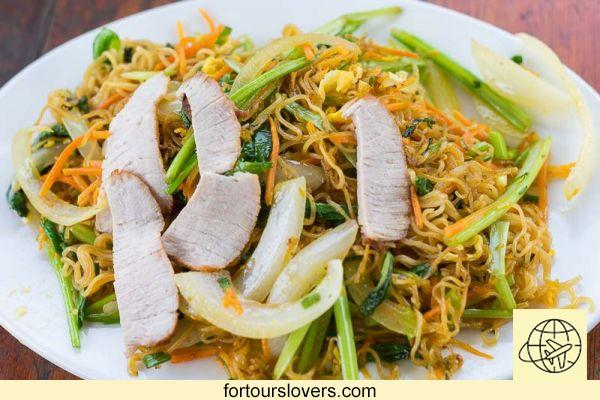
On one thing I am sure, hygiene is not at the highest level but I think you already know this. The advice is therefore to bring medicines with you that can help you in case of intestinal disorders.
However, I would like to give you some possible references on where to eat in the various cities of my itinerary. I didn't have many dinners in restaurants as many dinners were included in the excursions and in Hanoi I dined on classic street-food, but I can give you some advice for Sapa city and Hoi An.
- Sapa city -> The Hill Station Signature, beautiful restaurant overlooking the mountains, you can also eat on the low tables. The environment is elegant and its particularity is that it uses all local products.
- Hoi An -> Morning Glory Original, quite large and with many seats, excellent cuisine and price around 300.000 Dong for two dishes, for a complete and abundant dinner on 500.000 Dong. Courteous staff
- Hoi An -> Morning Glory 2, practically opposite the original is another restaurant of the same ownership as the previous one. The dishes on the menu are almost the same.
- Hoi An -> Home Hoi An Restaurant, was the coolest of Hoi An restaurants. It is one of the few that has air conditioning and seats are few. It is difficult to find a place without booking. The waiters are courteous, even too helpful and the price is on average high.
Read also: Hoi An, the romantic city of lanterns.
Night trains, my advice
Among the tips for traveling to Vietnam, I also want to include this small paragraph on night trains. While I was waiting for the cruise in the lobby of the Indochina Junk, an Italian girl, while I was talking to other Italian girls about my experience in Sapa, asked me with no little concern what the night train I had taken was like.
The question did not leave me perplexed because before leaving for Vietnam I had also wondered how the train conditions were.
Well, I can assure you that if you choose the VIP cabin for two or four people, cleaning is excellent. I didn't find any strange insects or animals and the train used was the Chapa Express.
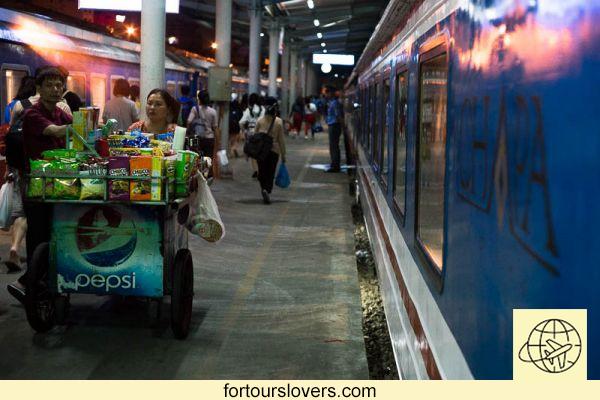
How to move between taxi and grab
You will often find yourself willing to need to travel by taxi from one area of the city to another or even simply to go to the beach as you might in Hoi An. Taxis are the perfect solution. They are cheap, clean and above all have air conditioning which I assure you will be a boon if you travel to Vietnam in August. The only problem is that they often don't know a word of English and sometimes they don't even know the place where you want to go and you have to show them on google Maps.
Now I'll explain everything, let's start with the rates.
A taxi in Vietnam could cost you from 9.000 to 16.000 Dong per kilometer with a starting base that can be between 6.000 and 16.000 Dong, at least for the ones I got on. To be more precise, if you travel 1 km with those with a starting rate of 6.000 Dong and 9.000 Dong per kilometer, the total cost will be 15.000 Dong, just over 50 euro cents.
It could happen that the taxi drivers propose you to them a flat rate price but rest assured it will be more convenient for them than for you. Sometimes, however, it may also be useful to haggle if you are in a hurry and do not want to wait for the next taxi. If you know more or less the kilometers you have to travel, do a quick calculation and if the rate that the taxi driver offers you is slightly different, accept.
It happened that for a journey of 90.000 Dong they asked me for 100.000 Dong as a lump sum, well 10.000 Dong is maybe 30 euro cents, would you expect another taxi for 30 euro cents? Not me. What is certain is that if they offer you 200.000 Dong you already know that the rate is very out of the ordinary.
In case of WiFi connection or data connection if you bought the local sim card, you might use GRAB and you shouldn't do any calculations.
HORNBEAM is an application widely used in Vietnam and the operation is similar to that of Uber. Through the application you can request the transfer from point A and point B and the app already shows you how much you will spend. They are not official taxis but they are still a reliable service as well as very comfortable. Once you enter the request, the app looks for an available driver that accepts your route. When a driver accepts your request, you are sent information about the driver, the license plate of the car and the type of car used.
Little nice parenthesis… they can also send you some messages like chat, it happened to me a couple of times that they sent smiley faces… let's forget it.
How to cross the road in Vietnam
It seems trivial but it is not. Forget right of way, pedestrian crossings and the green for pedestrians at the traffic lights. Put yourself in anarchy mode and cross your fingers at the same time.
Seriously. Crossing the road in Vietnam can be dangerous given the huge number of mopeds and the lack of aptitude for respecting road rules by anyone who drives a motor vehicle.
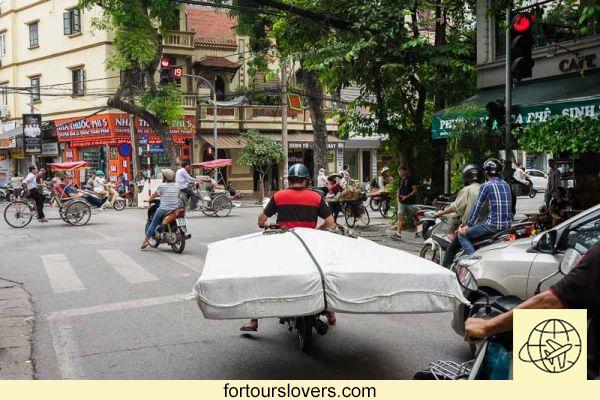
When you cross the street you have to be determined, go to plan but be sure that the scooter that is coming towards you has seen you and changes direction.
If you pay attention and are determined, nothing happens. In the city, cars and mopeds go slowly, they ring all the time but don't worry because that is simply their way of communicating their presence on the road.
Backpack or trolley: which is the best solution?
Whenever I find myself having to pack my suitcase, I'm always in league with using a trolley or a backpack.
Let's say that due to the nature of the trip, using a lot of public transport, the backpack would be preferable because it allows you to keep your hands free and not having to drag anything. So if you love traveling with a backpack you will be at ease.
I don't like traveling with a backpack and, therefore, I always end up filling my trolley. Despite being less practical to carry around, I didn't have any problems.
Data connection, WiFi and electrical outlets in Vietnam
You may be in the most remote valleys of Sapa that you will still find a WiFi. Jokes aside WiFi is especially popular in Vietnam. Every club, hotel and cafe has a WiFi connection and they all work pretty well. Just think that the train from Sapa to Hanoi also had it. The cities themselves have free connections.
The curious thing is that the Vietnamese have a particular passion for numeric WiFi keys. You will find many passwords such as 123456789 or 11223344, etc etc.
The data connection has good coverage, if you want to be safer and not just take advantage of the WiFi connections of the various bars, I recommend that you buy a local sim card.
For electrical outlets you will find 90% traditional 220v plugs, sometimes old sockets, flat type, could happen to you, for this reason and to be safer I recommend that you bring a universal adapter with you.
Do it yourself VS Guided tours
I'm usually a hard believer in DIY. On this trip to Vietnam I preferred to rely on two different local agencies for the cruise and trekking in Sapa.
Do-it-yourself assumes you have more time and I didn't have any available.
In Sapa it will be up to you to decide whether to go on an organized trek or walk alone; for Halong Bay, however, it is very complicated to get out of the classic tourist routes even if it is not impossible. I admit that for some reasons I would have preferred something less touristy but with Ha Long it's difficult to find alternative solutions.
Conclusions
I hope these tips will help you organize your trip to this beautiful country of which for now I have only spoiled an "appetizer". Vietnam is a country that deserves many days of travel. If you need any other advice or any questions, do not hesitate to comment on the post, I will get back to you as soon as possible.




